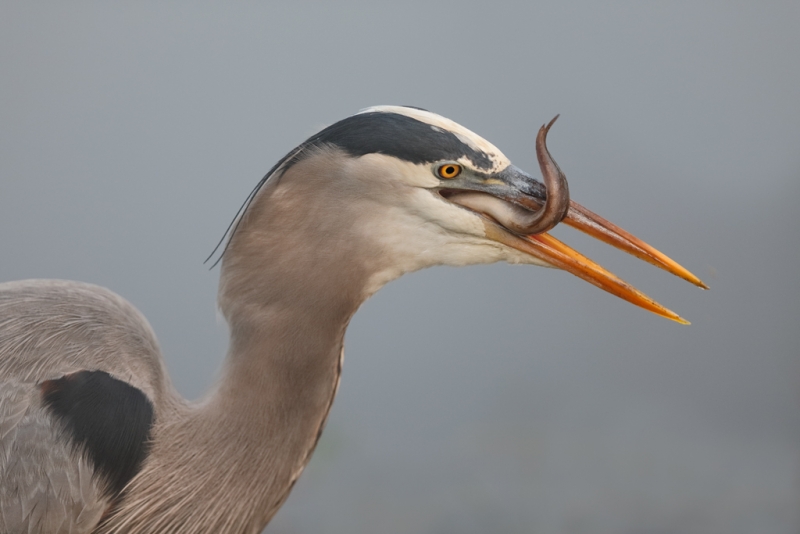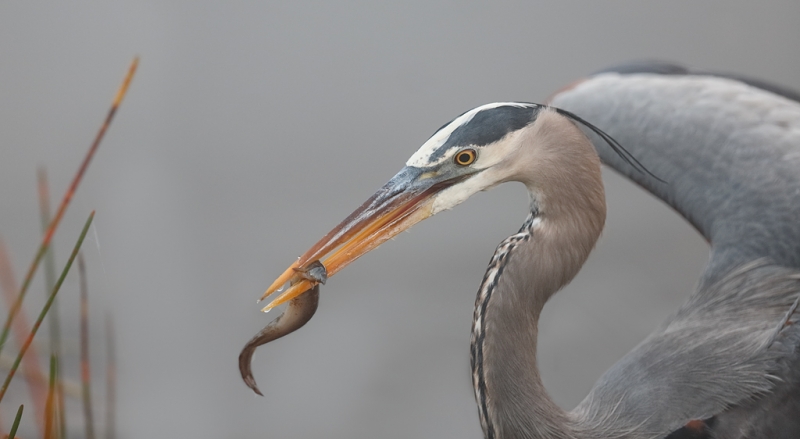|
This Great Blue Heron was photographed at Anhinga Trail with the hand held Canon EF 300mm f/2.8L IS II USM lens and the Canon EOS-1D X Digital SLR camera. ISO 800. Evaluative metering +1 1/3 stops as framed: 1/500 sec. at f/2.8. 61-point/AI Servo/Rear Focus AF active at the moment of exposure. Click here if you missed the Rear Focus Tutorial. Click on the image to see a larger version. |
The Canon 300mm f/2.8L IS II in Low Light
I set out each morning at Anhinga Trail with the 600 II on my shoulder on a tripod with a 1D X mounted to it and both the 70-200 f/2.8L & the 24-105mm in my vest. In my left hand I held the 300 f/2.8L IS lens with a 1D X on it. When I came upon a situation that I wanted to photograph, I placed the vest on the asphalt walkway or the boardwalk and went with either the 600 II or the 300 II. I was photographing this Great Blue Heron with the hand held 300 II on a very foggy morning. I was sitting low shooting under the small wooden railing that abuts Taylor Slough. In the low light and fog it only made sense to go without the 1.4X TC and get as close as possible. I started off adding a bit too much light and cut back to +1 1/3 after noting some blinkies on the bird’s crown.
I missed the strike but created a long series of images of the bird with its breakfast. After he attempted and failed to swallow the prey item the bird dropped it on the ground and started over. Eventually, he was successful.
|
This Great Blue Heron was photographed at Anhinga Trail with the hand held Canon EF 300mm f/2.8L IS II USM lens and the Canon EOS-1D X Digital SLR camera. ISO 800. Evaluative metering +1 1/3 stops as framed: 1/320 sec. at f/3.2. 61-point/AI Servo/Rear Focus AF active at the moment of exposure. Click here if you missed the Rear Focus Tutorial. Click on the image to see a larger version. |
What Is It?
If anyone has a clue as to what the prey item is, please leave a comment. If you know for sure, that would work well too. I am thinking that it is not a fish. And that possibly it is an amphibian, some the larval stage of a salamander species….
Questions
If you have any questions on my choice of aperture or on the exposure settings, or anything else for that matter, fire away.
MP4 Photoshop Tutorial Videos
See and hear me at work in Photoshop in these great MP4 instructional videos. Cheap! You can see them all and learn more here and learn about our latest offering here.
Southwest Florida IPT $600 Late Registration Discount!
If you would like to join us on the Southwest Florida IPT (see below) please call Jim on Monday at 863-692-0906 to register or shoot me an e-mail to save one of the two availble spots for you. Or contact me via e-mail for a pro-rated quote if you can make only part of this great IPT.
SW FLA IPT. FEB 16-21, 2013. Introductory slide program: 7pm on 2/15. 6-FULL DAYS: $2999. Co-leaders: Denise Ippolito and Robert Amoruso. Limit: 10/Openings 2 due to two late cancellations
Payment in full is due now
This is my bread and butter IPT; learn the basics and the advanced fine points from the best; escape winter’s icy grip and enjoy tons of tame birds! Subjects will include nesting Great Blue Heron and Great Egret, Mottled Duck, Brown and White Pelican at point-blank range, Snowy & Reddish Egret, Tricolored Heron, Yellow-crowned Night Heron, Osprey, wintering shorebirds and plovers, gulls and terns, & Burrowing Owl. All ridiculously tame. Roseate Spoonbill, Black-bellied Whistling Duck, American Oystercatcher, and who knows what are possible.
Click here to learn more about this IPT.
Typos
On all blog posts, feel free to e-mail or leave a comment regarding any typos, wrong words, misspellings, omissions, or grammatical errors. Just be right. 🙂
Support the BAA Blog. Support the BAA Bulletins: Shop B&H here!
We want and need to keep providing you with the latest free information, photography and Photoshop lessons, and all manner of related information. Show your appreciation by making your purchases immediately after clicking on any of our B&H or Amazon Affiliate links in this blog post. Remember, B&H ain’t just photography!
Support the BAA Blog. Support the BAA Bulletins: Shop Amazon here!
And from the BAA On-line Store:
LensCoats. I have a LensCoat on each of my big lenses to protect them from nicks and thus increase their re-sales value. All my big lens LensCoat stuff is in Hardwood Snow pattern.
LegCoat Tripod Leg Covers. I have four tripods active and each has a Hardwood Snow LegCoat on it to help prevent further damage to my tender shoulders 🙂 And you will love them in mega-cold weather....
Gizo GT3532 LS CF Tripod. This one replaces the GT3530LS Tripod and will last you a lifetime. Learn more about this great tripod here.
Mongoose M3.6 Tripod Head. Right now this is the best tripod head around for use with lenses that weigh less than 9 pounds. For heavier lenses, check out the Wimberley V2 head.
Double Bubble Level. You will find one in my camera's hot shoe whenever I am not using flash.
The Lens Align Mark II. I use the Lens Align Mark II pretty much religiously to micro-adjust all of my gear an average of once a month and always before a major trip. Enjoy our free comprehensive tutorial here.
BreezeBrowser. I do not see how any digital photographer can exist without this program.
Delkin Flash Cards. I use and depend on Delkin compact Flash Cards and card readers most every day. Learn more about their great 700X and 1000X cards here or about my favorite Delkin card here.
















A query Art
Now that you have the 200-400, what all would you have carried if you were to go for this shoot tomorrow
The 200-400 would be great for Anhinga Trail. artie
Definitely some species of fish. It is 100% not a Siren, Dwarf Siren, or Amphiuma, which are the eel-like amphibians that occur in south Florida(and all species I have a lot of experience with).
Nice work on a foggy morning Artie. I always seem to run into trouble shooting in these conditions :-(. No idea about the prey item.
Artie
Looks to me like a Two-toed Amphiuma (Amphiuma means).
Hard to see, but if those are front legs, then this looks like a baby Siren to me Art.
Hi, Artie. Great images as always. As for what the heron’s breakfast is, well, beyond saying it’s a fish, I don’t know. It doesn’t look like an eel to me–it actually looks like an eel-blenny, but I don’t know if there are any in the Everglades. There are quite a few exotic and many native fish species there, and it wouldn’t be surprising that your bird found a species not previously known from there. If you were close to saltwater (say near Flamingo), then there are a bunch of marine species it could have been as well. If you can send me a crop, I might be able to recognize it but certainly could send it to someone who would.
Hi!
Wouldn’t 1/250 @ f/4 given you more detail on the head feathers?
Cheers!
Neil
Going in these images, Artie’s eel has a dorsal fin, anal fin and a tail fin. The Asian eel has none of these fins. The snout is much longer than the asian eel and the overall length is much shorter than an asian eel of that width. The spots are not showing but there are “Peacock” type eels that do not have the spots and are kept in the tropical fish hobby. Cropped blowups from the raw images would reveal much more info.
Sorry, you’re all wrong. It’s the strap from a Nikon D4 that’s been swallowed by the 1Dx. lol
Nice shootin’, pardna.
mark
I believe it is a siren salamander
A peacock eel has a blunt tail with spots on it. The eel in Artie’s image has a tapered tail & no spots. This leads me to think that it is an asian swamp eel instead of a peacock eel.
I just googled Peacock Eel and it looks good for your wiggler!
Hi Artie. It looks to me like an eel. Possibly an introduced species of eel. The pointed snout looks similar to many of the eels that I have seen in tropical fish stores. There are many, many tropical fish farms in Fl. Many have outdoor stock ponds that get flooded with just about every hurricane, thus many aquatic species escape into the waterways. A crop of the fish may help with id by someone with more knowledge than I.
Asian Swamp Eel, an invasive species.
http://abcnews.go.com/Technology/story?id=119910&page=1
Hi Art,
It apears to me as an old aquarist and biologist that we dealing here with an exotic none-native species i.e. an escapy from the aqarium trade…. and is an Asian Spiny eel specie. You never know what exotic species Florida fishing birds will come up with.
Klaus